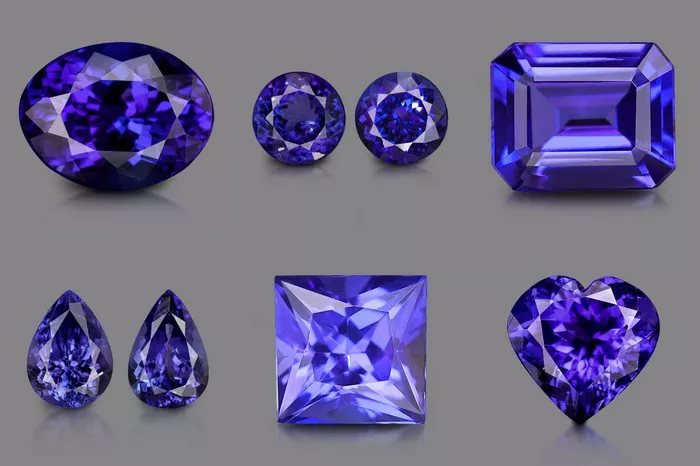Tanzanite, a gemstone discovered in the foothills of Mount Kilimanjaro in Tanzania, is known for its striking blue and violet hues. This gemstone, a variety of the mineral zoisite, has captured the attention of jewelers and collectors worldwide due to its unique color-changing properties and relative rarity. The question of whether Tanzanite is better blue or purple is a subject of much debate among enthusiasts. This article will explore the factors influencing Tanzanite’s color, its market value, and personal preferences to provide a comprehensive answer.
The Science Behind Tanzanite’s Colors
Tanzanite’s color is a result of its crystal structure and the presence of trace elements like vanadium. When viewed from different angles, Tanzanite exhibits a phenomenon known as pleochroism, displaying three distinct colors: blue, violet, and burgundy. The intensity and dominance of these colors can vary based on several factors:
Heat Treatment: Most Tanzanite on the market undergoes heat treatment to enhance its blue and violet hues. Natural Tanzanite tends to be brownish before treatment. The process involves heating the stone to about 600 degrees Celsius, which reduces the brownish tinge and brings out the vibrant blues and purples.
Lighting Conditions: The appearance of Tanzanite can change dramatically under different lighting conditions. Under daylight or fluorescent light, Tanzanite often shows a stronger blue hue, while incandescent lighting tends to bring out its violet tones.
Cut and Orientation: The way a Tanzanite is cut can affect its color display. Jewelers often orient the gemstone to maximize its most desirable color. For instance, a cut that emphasizes the blue aspect may be preferred for some, while others might prefer a cut that showcases more purple.
Market Preferences and Value
The color of Tanzanite significantly influences its market value. Generally, there is a preference for deeper, more saturated colors, but whether blue or purple is more desirable can vary.
Blue Tanzanite: Traditionally, the most highly valued Tanzanite exhibits a rich, deep blue, often compared to the finest sapphires. This preference stems from the rarity and the striking appearance of a deep blue stone. The blue Tanzanite is especially coveted in Western markets, where it’s seen as a symbol of luxury and sophistication.
Purple Tanzanite: In recent years, there has been a growing appreciation for Tanzanite with a strong violet or purple hue. This color is often seen as more unique and exotic, offering a different kind of appeal compared to the classic blue. Collectors who seek to differentiate their collection may gravitate towards the more violet stones.
Bi-Color Tanzanite: Some enthusiasts and collectors prefer Tanzanite that exhibits a balanced mix of blue and purple. These stones can be particularly captivating as they showcase Tanzanite’s pleochroic nature, changing color under different lights and angles.
Factors Influencing Personal Preference
Personal preference plays a significant role in determining whether blue or purple Tanzanite is better. Here are some factors that might influence an individual’s choice:
Aesthetic Appeal: Some people are naturally drawn to the deep, tranquil quality of blue gemstones, associating them with calmness and elegance. Others might prefer the vibrant and energetic feel of purple, which can be seen as more dynamic and creative.
Fashion and Trends: Fashion trends can also sway preferences. For instance, certain seasons or years might see a rise in the popularity of blue gemstones in the jewelry market, while other times might favor purple.
Symbolism: The colors blue and purple carry different symbolic meanings that might appeal to different individuals. Blue is often associated with stability, trust, and tranquility, while purple is linked to luxury, mystery, and spirituality.
Cultural Significance: In some cultures, specific colors hold particular significance, which can affect preferences. For instance, blue might be favored in cultures where it’s seen as a symbol of protection and peace, while purple might be preferred in regions where it represents royalty and wisdom.
See Also: Lighter vs. Darker Tanzanite
Practical Considerations in Choosing Tanzanite
When choosing between blue and purple Tanzanite, practical considerations also come into play:
Jewelry Design: The design and purpose of the jewelry piece can influence the choice of color. Blue Tanzanite might be preferred for more formal pieces like engagement rings or statement necklaces, while purple Tanzanite might be chosen for more artistic or casual designs.
Skin Tone: Some jewelers and customers consider how the gemstone’s color complements the wearer’s skin tone. Blue gemstones often look striking against lighter skin tones, while purple stones can enhance the appearance of darker or warmer skin tones.
Versatility: Blue Tanzanite might be seen as more versatile, matching a wider range of outfits and occasions, while purple Tanzanite might be chosen for its uniqueness and ability to stand out.
Conclusion
Ultimately, whether Tanzanite is better blue or purple is a matter of personal preference influenced by a variety of factors. The gemstone’s pleochroic nature means that it can offer the best of both worlds, displaying different colors in different lights and angles.
For those who value tradition and the classic appeal of a deep blue gemstone, blue Tanzanite is likely the better choice. It’s elegant, highly sought after, and carries a sense of timeless beauty. On the other hand, for those who appreciate uniqueness, creativity, and a touch of the exotic, purple Tanzanite might be the preferred option. Its vibrant hue and rarity make it a standout choice for collectors and fashion-forward individuals.
In the end, the best Tanzanite color is the one that resonates most with the individual’s taste, style, and personal significance. Both blue and purple Tanzanite have their own distinct charms, making this gemstone a versatile and enchanting choice for anyone looking to add a touch of natural beauty to their collection.


